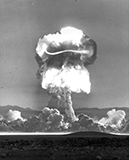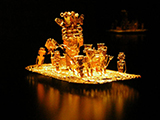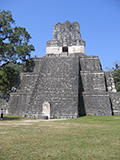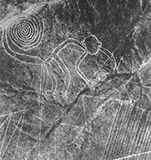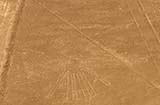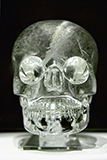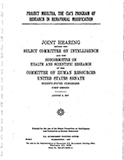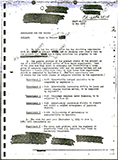Kingdom of the Crystal Skull
Last Crusade | Kingdom of the Crystal Skull
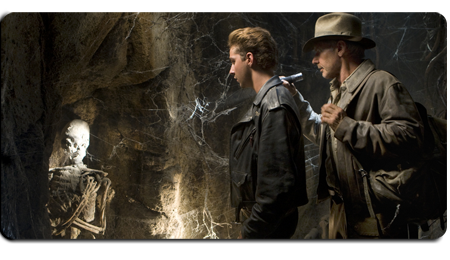
Indy's most recent adventure places him in the heat of the Cold War and once again pursuing an artifact that places the freedom of humanity at risk. Many familiar faces as well as some new ones accompany Indy on his journey to solve the mystery of the Kingdom of the Crystal Skull. Join us as we explore the true archaeology and history behind Indy's final adventure. Find out if the crystal skulls are real and why they are associated with the Mesoamerican culture. Learn more about the mystery of the Nazca Lines. Discover the truth behind Akator and hop in your lead-lined fridge as we examine Operation Plumbbob, the nuclear test in which Indy unwillingly participated.

Operation Plumbbob
One of the most memorable scenes from Kingdom of the Crystal Skull is when Indiana Jones is trapped at a “Doom Town” nuclear test site. Indy quickly searches the fake neighborhood and home for a refuge, finally jumping into a lead-lined refrigerator where he is remarkably saved from the intense radiation of the blast.
After America dropped the first atomic bomb on Hiroshima in 1945, a new age began. Since that time, global powers have been in an arms race to secure their place in the nuclear world. Perhaps the best known of these atomic rivalries was between the United States and the Soviet Union… a time more commonly known as the Cold War. Throughout this arms race both countries were working to construct the most deadly nuclear weapons. Although most tests were banned in the 1960’s, nuclear tests were somewhat common throughout the first decades of the Cold War. In the United States, most of the nuclear testing was done in the western deserts of New Mexico and Nevada. In some cases, test buildings or “doom towns” were constructed to measure the effects of the bomb on residential and populated areas. Nuclear testing was also performed at sea, most notably at the Bikini Atoll in the Pacific.
It cannot be said with certainty which nuclear test Indiana Jones experienced, but it was most likely Operation Plumbbob. These tests occurred between May 28 and October 7, 1957 matching the location and timeline of the film. This series of tests is noted for the possibility that the first manmade object may have been launched into space. During one of the tests, a steel plate cap was, at detonation, launched from the top of a test shaft at a speed of approximately 41 miles per second. Because the plate was never located, some people believe that it was launched out of earth’s atmosphere making it the first manmade object to be placed in space. Others believe the plate likely disintegrated due to the velocity and subsequent extreme heat that was generated.
Learn More
-Video: "Owens" shot of Operation Plumbbob-Operation Plumbbob Tests
-United States Nuclear Tests, July 1945 through September 1992
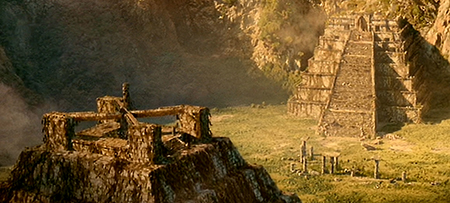
Akator
The driving force behind the film is to locate the fictional city of Akator. In the film, Indiana Jones also refers to it as the “city of gold” or El Dorado. We later find out that there is indeed gold in Akator, but the true treasure is knowledge... albeit from aliens, but it’s still a humbling message.
Stories of El Dorado date back to the Spanish conquest of the Americas. The first known account of El Dorado comes from El Carnero by Juan Rodriguez Freyle. In 1638 a story was told of a Muisca chief who covered himself with gold dust and dove into Guatavita Lake (part of an initiation ceremony). The term El Dorado means “gilded one,” an obvious reference to the chief in the story. Accounts also say the chief would ride a raft across the lake and drop golden offerings to their gods.
The Muisca’s association with gold, coupled with rumors of a “city of gold” enticed the Spanish to hunt out the place they began to call El Dorado. Famed conquistadors like Francisco Orellana and Gonzalo Pizarro led expeditions searching for El Dorado beginning in 1540. However, despite numerous searches, no evidence has ever been found that any such city ever existed. Perhaps the best thing to come out of Orellana’s search for El Dorado was his discovery of the Amazon River.
Learn More
-The Legend of ‘El Dorado’-El Dorado Legend Snared Sir Walter Raleigh
-Amazon explorers uncover signs of a real El Dorado
-BBC: The Secret of El Dorado
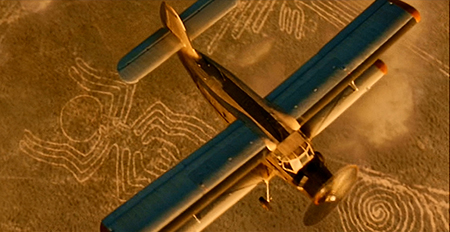
Nazca Lines
The Nazca Lines are a series of large geoglyphs constructed by the Nazca Indians around 400 BC. Located in Nazca, Peru little is known regarding the purpose of the various geoglyphs. The well-constructed glyphs range in design from humans and insects to birds and extraordinary lines.
Due to the complexity and size of the shapes, historians often debate how a simple people constructed the glyphs over 2,000 years ago. A common theory is that a crude hot air balloon system was developed by the Nazca to elevate overseers above the construction zones. Perhaps a bigger and more ominous question is why did the Nazca build the geoglyphs in the first place?
It is widely believed that the large figures were constructed for the heavenly gods of the Nazca to see. Others believe the lines have an astrological purpose, much like other structures found throughout South America and Latin America. Another contemporary theory behind the lines is that they were constructed to indicate underwater water resources… a much needed life source for the Nazca people.
Some believe that the lines were constructed as tributes or symbols to alien beings. The strange line shapes are sometimes used in this theory and described as runways or landing sites for extraterrestrial craft. Certainly in Kingdom of the Crystal Skull, the Nazca figures are used as a plot device along the lines of extraterrestrial beings and their influence on humanity.
Perhaps what’s most impressive about the Nazca Lines is that they have remained largely intact and undisturbed for over 2,000 years. This is mainly due to the fact that on the ground, the lines are rather insignificant and garner little attention. It wasn’t until the 20th Century that human flight made it possible to grasp the scope of the Nazca Lines.
The construction method of the lines is also debated, but it is likely that the Nazca used a simple surveying system to lay out the lines. This was followed by digging shallow trenches and removing the reddish surface dirt and rocks to expose the lighter colored earth beneath the contrasting soil.
Learn More
-Discover Peru: Nazca Lines-ODP- Nazca Lines
-Photos of the Nazca Lines
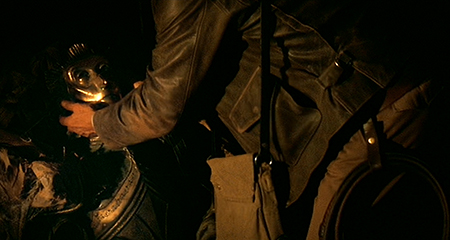
Francisco de Orellana
In the film, Indy discovers the crystal skull within the burial site of conquistador and explorer, Francisco de Orellana. Although no connection can be made to Orellana and any of the known crystal skulls, he can be tied to the search for El Dorado.
Orellana was born in Trujillo, Spain around 1511. By 1527 he had travelled to the New World and began serving in the army of his friend (possibly relative) Francisco Pizarro by 1533. Pizarro is best known for his conquering of the Inca in 1532.
In 1540, Pizarro ordered Gonzalo Pizarro to locate El Dorado or the “city of gold.” Orellana was sent along as one of Pizarro’s lieutenants. Although the expedition caused the deaths of hundreds of Spaniards and thousands of natives, El Dorado was never found. Pizarro eventually turned back, but ordered Orellana to continue his exploration of the Coca River and to return when he had found its end. A year later Orellana would discover the Amazon River, leading to numerous future expeditions.
Orellana reportedly named the river after the women warriors, the Icamiabas, who attacked his group prior to the river’s discovery. Another account actually gives the naming credit to Spanish king, Charles I, who was inspired by the story of the women warriors and their attack on Orellana. Charles I chose the name Amazons from the Greek legend.
Learn More
-Britannica: Francisco de Orellana-BBC: The Secret of El Dorado

Crystal Skulls
The McGuffin of the most recent Indiana Jones film is its namesake, the crystal skull. We are told in the film that the skull possesses a mystical, even extraterrestrial influence that can overpower a human mind. After all, this is the Soviet interest in the object… mind control. As with most McGuffins in the Indiana Jones series, there is some truth found within the story.
Crystal skulls first began popping up in the late 19th century and their discoverers claimed they were found in Latin or South America and were pre-Columbian (predating Columbus’ arrival in the New World). Numerous examples have been found and like the film points out, many of the skulls show terrific detail and would require a mastery of carving. Those who believe the skulls came from extraterrestrial beings often reference the intricate details and lack of machine marks. A 2008 study published in the Journal of Archaeological Science found that the Smithsonian and British Museum skulls did in fact show signs that an highly abrasive substance was used to craft the skulls. To the human eye, however, these markings are practically invisible.
Perhaps the most well-known of the crystal skulls is the Mitchell-Hedges skull. It was “discovered” in 1924 by Anna Le Guillon Mitchell-Hedges. She claimed to have found the skull under an ancient temple’s altar in modern day Belize. It is often noted that the Mitchell-Hedges skull bears a close resemblance to the one displayed at the British Museum. Another challenge of the story comes from the people present at the Mitchell-Hedges dig site. No one has ever come forward to back up Mitchell-Hedges’ story or account for her presence at the site.
No evidence has been found in Mesoamerican mythologies that would offer any credibility to the use of crystal skulls in the region. This fact often leads skeptics to believe that the skulls were modern creations (late 1800’s) almost certainly made in Europe and not the Americas. None of the known skulls have ever been proven to be pre-Columbian, but that does not stop people from being fascinated with them. Believers herald the skulls as having a strange, mystical power that overcomes them when gazing into the eyes of the skull. Regardless of their true origins, crystal skulls continue to fascinate and challenge what we know about ancient Americans.
Learn More
-NatGeo: Crystal Skulls-Archaeology.org: Crystal Skulls
-British Museum: Rock crystal skull
-Mitchell-Hedges Skull
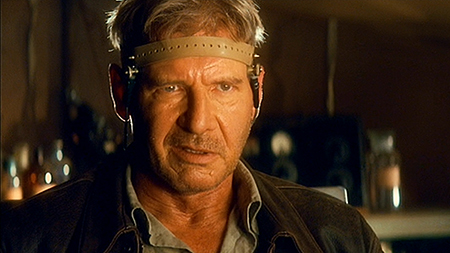
Human Mind Control
With the timeline of the film set in the 1950’s, the natural antagonist of the film was the Soviet Union, represented through Dr. Irina Spalko. It is revealed that the Soviets are experimenting with the possibility of mind control and seek the crystal skull to aid them in this mission. Much like the Nazis and their pursuit of powerful religious relics, the Soviets plan to use the mind-controlling power of the skull to destroy America and take over the world.
While the idea behind mind control certainly seems silly and very outlandish, there is much truth behind the governmental use or attempted use of mind control. It is well known that the Nazis did psychological studies on human subjects throughout their fearful reign over most of Europe. The United States has also experimented in the realm of mind control. Beginning in the early 1950’s, the Central Intelligence Agency was involved in a covert research program known as MKUltra. Subjects were given numerous tests involving everything from hypnosis and sensory deprivation to sexual abuse and administration of drugs like LSD. The program had been completely aborted by the early 1970’s and, due to the destruction of numerous classified documents, MKUltra is often referenced as a source for countless conspiracy theories involving the US government.
It is also known that the Soviet Union also performed experiments in telepathy. There was also concern in the US that the Soviets had developed chemical agents that would greatly influence enemy minds. Perhaps out of fear, it is the United States that seems to have performed the most studies and experiments on human psychology. The debate surrounding the ethicality of these experiments continues to this day.
Learn More
-Hypnosis and the Fear of Mind Control-CIA MKULTRA Collection
-Documentary: The Most Dangerous Game
-Streatfeild, Dominic. Brainwash: The Secret History of Mind Control. Thomas Dunne Books, 2007.
Disclaimer: All resources (including books and websites) provided on indyintheclassroom.com are intended to be used by educators. Indyintheclassroom.com is not responsible for the content on linked websites.
Copyright: All images on Indyintheclassroom.com are used with permission or are in the public domain. Exceptions are noted. For additional information see our Copyright section. |
Last Crusade | Kingdom of the Crystal Skull

